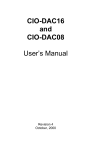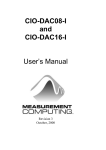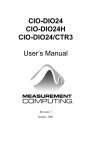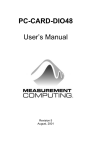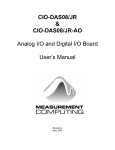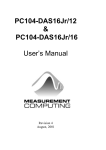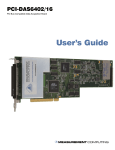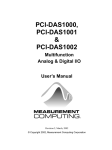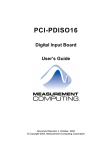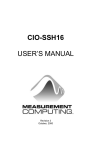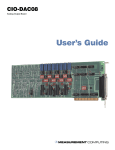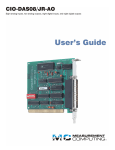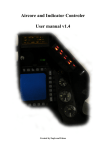Download Word Pro - HM CIO-DAC##_16.lwp
Transcript
CIO-DAC08/16 and CIO-DAC16/16 User’s Manual Revision 6 April, 2001 MEGA-FIFO, the CIO prefix to data acquisition board model numbers, the PCM prefix to data acquisition board model numbers, PCM-DAS08, PCM-D24C3, PCM-DAC02, PCM-COM422, PCM-COM485, PCM-DMM, PCM-DAS16D/12, PCM-DAS16S/12, PCM-DAS16D/16, PCM-DAS16S/16, PCI-DAS6402/16, Universal Library, InstaCal, Harsh Environment Warranty and Measurement Computing Corporation are registered trademarks of Measurement Computing Corporation. IBM, PC, and PC/AT are trademarks of International Business Machines Corp. Windows is a trademark of Microsoft Corp. All other trademarks are the property of their respective owners. Information furnished by Measurement Computing Corp. is believed to be accurate and reliable. However, no responsibility is assumed by Measurement Computing Corporation neither for its use; nor for any infringements of patents or other rights of third parties, which may result from its use. No license is granted by implication or otherwise under any patent or copyrights of Measurement Computing Corporation. All rights reserved. No part of this publication may be reproduced, stored in a retrieval system, or transmitted, in any form by any means, electronic, mechanical, by photocopying, recording or otherwise without the prior written permission of Measurement Computing Corporation. Notice Measurement Computing Corporation does not authorize any Measurement Computing Corporation product for use in life support systems and/or devices without the written approval of the President of Measurement Computing Corporation Life support devices/systems are devices or systems which, a) are intended for surgical implantation into the body, or b) support or sustain life and whose failure to perform can be reasonably expected to result in injury. Measurement Computing Corp. products are not designed with the components required, and are not subject to the testing required to ensure a level of reliability suitable for the treatment and diagnosis of people. (C) Copyright 2001, Measurement Computing Corporation HM CIO-DAC##_16.lwp Table of Contents 1.0 INTRODUCTION . . . . . . . . . . . . . . . . . . . . . . . . . . . . . . . . . . . . . . . . . . . . . . . . 1 2.0 SOFTWARE INSTALLATION . . . . . . . . . . . . . . . . . . . . . . . . . . . . . . . . . . . . . 1 3.0 HARDWARE INSTALLATION . . . . . . . . . . . . . . . . . . . . . . . . . . . . . . . . . . . . 2 3.1 BASE ADDRESS . . . . . . . . . . . . . . . . . . . . . . . . . . . . . . . . . . . . . . . . . . . . . . . 2 3.2 ANALOG OUTPUT RANGE JUMPERS . . . . . . . . . . . . . . . . . . . . . . . . . . . . 4 3.3 UNIPOLAR/BIPOLAR INITIAL ZERO STATE JUMPER . . . . . . . . . . . . . . 4 3.4 SIMULTANEOUS UPDATE JUMPER . . . . . . . . . . . . . . . . . . . . . . . . . . . . . . 5 3.5 INSTALLING THE BOARDS IN THE COMPUTER . . . . . . . . . . . . . . . . . . 6 3.6 CABLING TO THE BOARD . . . . . . . . . . . . . . . . . . . . . . . . . . . . . . . . . . . . . . 6 3.7 SIGNAL CONNECTION . . . . . . . . . . . . . . . . . . . . . . . . . . . . . . . . . . . . . . . . . 7 3.8 CONNECTOR DIAGRAM . . . . . . . . . . . . . . . . . . . . . . . . . . . . . . . . . . . . . . . 8 4.0 REGISTER ARCHITECTURE . . . . . . . . . . . . . . . . . . . . . . . . . . . . . . . . . . . . . 9 4.1 CONTROL & DATA REGISTERS . . . . . . . . . . . . . . . . . . . . . . . . . . . . . . . . . 9 4.2 OUTPUT TRANSFER FUNCTIONS . . . . . . . . . . . . . . . . . . . . . . . . . . . . . . 10 5.0 SPECIFICATIONS . . . . . . . . . . . . . . . . . . . . . . . . . . . . . . . . . . . . . . . . . . . . . . 12 This page is blank. 1.0 INTRODUCTION The CIO-DAC16/16 is a 16-channel analog output board. The CIO-DAC08/16 is an 8-channel analog output board. The analog outputs are from AD660BNs with each output buffered by an OP-27. The analog outputs are controlled by writing a digital control word as two bytes to the DAC's control register. The control register is double buffered so the DAC's output is not updated until the second byte (the high byte) has been written. The analog outputs may also be set for simultaneous update by selecting XFER on jumper J18. This jumper applies to all DACs. When the DACs are set for simultaneous update, writing new digital values to a DAC's control register does not cause an update of the DAC's voltage output. Update of the output occurs only after a READ from the board's addresses (any address from base + 0 through base + 31, or through base +15 for the DAC08). 2.0 SOFTWARE INSTALLATION The CIO-DAC##/16 is supplied with InstaCal. InstaCal is an installation, calibration and test package. Use it to guide the installation procedure. InstaCal also creates a configuration file required for programmers who have purchased the Universal Library programming libraries. Refer to the Software Installation Manual for complete instructions. If you decide not to use InstaCal as a guide, the information required for configuring the board is provided in the following section. 1 3.0 HARDWARE INSTALLATION The CIO-DAC16/16 and DAC08/16 each has one bank of range jumpers, a single unipolar/bipolar jumper, one base address switch and a simultaneous update jumper which must be set before installing the board in your computer. The InstaCal program included with both boards shows how these switches are set. Run this program before you open your computer. We recommend you perform the software installation described in sections below prior to installing the board in your computer. The InstaCalTM program provided will show you how to properly set the switches and jumpers on the board prior to physically installing the board in your computer. The CIO-DAC16/16 is setup at the factory with: BASE ADDRESS SIMULTANEOUS UPDATE ANALOG OUTPUT UNI / BIP JUMPER 300h (768 decimal) In the UPDATE position. Single channel update. ±5V BIP 3.1 BASE ADDRESS Unless there is already a board in your system which uses address 300h (768 decimal) leave the switches as they are set at the factory. The base address switch for the CIO-DAC16/16 is shown here, set to 300 hex. The CIO-DAC08/16 has one additional switch on the base address switch bank (A4 with a weight of 10 hex). Figure 3-1. Base Address Switches (Set to 300h) The address switches may be set for a base address in the range of 000-3E0 (3F0 for the DAC08) so it should not be hard to find a free address area. Once again, if you are not using IBM prototyping cards or some other board which occupies these addresses, then 300-31Fh are free to use. Addresses not specifically listed, such as 390-39F, are free. Refer to table 3-1 for PC I/O address usage. 2 HEX RANGE 000-00F 020-021 040-043 060-063 060-064 070-071 080-08F 0A0-0A1 0A0-0AF 0C0-0DF 0F0-0FF 1F0-1FF 200-20F 210-21F 238-23B 23C-23F 270-27F 2B0-2BF Table 3-1. PC I/O Addresses FUNCTION HEX RANGE 8237 DMA #1 2C0-2CF 8259 PIC #1 2D0-2DF 8253 TIMER 2E0-2E7 8255 PPI (XT) 2E8-2EF 8742 CONTROLLER (AT) 2F8-2FF CMOS RAM & NMI MASK (AT) 300-30F DMA PAGE REGISTERS 310-31F 8259 PIC #2 (AT) 320-32F NMI MASK (XT) 378-37F 8237 #2 (AT) 380-38F 80287 NUMERIC CO-P (AT) 3A0-3AF HARD DISK (AT) 3B0-3BB GAME CONTROL 3BC-3BF EXPANSION UNIT (XT) 3C0-3CF BUS MOUSE 3D0-3DF ALT BUS MOUSE 3E8-3EF PARALLEL PRINTER 3F0-3F7 EGA 3F8-3FF 3 FUNCTION EGA EGA GPIB (AT) SERIAL PORT SERIAL PORT PROTOTYPE CARD PROTOTYPE CARD HARD DISK (XT) PARALLEL PRINTER SDLC SDLC MDA PARALLEL PRINTER EGA CGA SERIAL PORT FLOPPY DISK SERIAL PORT 3.2 ANALOG OUTPUT RANGE JUMPERS The analog output voltage range of each channel is set with a jumper. The jumpers are located on the board directly below the calibration potentiometers and are labeled J1 through J8 on the DAC08 and. J1 through J16 on the DAC16. Set the jumpers for an individual channel as shown in Figure 3-2. Figure 3-2. Range Jumpers The available ranges are: 0 to 5V (Unipolar) 0 to 10V (Unipolar) ±5V (Bipolar) ±10V (Bipolar) 3.3 UNIPOLAR/BIPOLAR INITIAL ZERO STATE JUMPER The CIO-DAC16/16 and DAC08/16 boards have a unipolar/bipolar jumper which selects the unipolar/bipolar initial zero state of the DAC output on either power-up or reset. There is a single jumper for the entire board (Figure 3-3). This jumper is located near the ISA bus connector. At power-up, the value in the DACs will be set according to Table 3-2. State of UNI/BIP Jumper UNI BIP Table 3-2. DAC Initial States at Power-up DAC Code IF DAC set for Unipolar Output 0 0.000 32768 Mid Scale 4 If DAC set for Bipolar Output Minus Full Scale 0.000 This jumper affects ONLY the power-up / reset condition of the DACs. It is here to insure that when the computer is turned on, or, if the computer is reset, process controls will come up in a known, safe state. Figure 3-3. Initial State Range Select Jumper Positions If your application requires that the output of all DACs maintain a zero state initially, you should use simultaneous update mode. This mode allows you to set the value stored in the output registers before the output voltage is updated. If individual update mode is used, the value of all DAC outputs will be updated to whatever value is stored in the output registers at the moment that the first DAC is updated. This value is undefined but typically will be + full scale (register value = FFFFh). Using the simultaneous mode allows you to set the values of all registers before any of the DACs are updated to the register value. 3.4 SIMULTANEOUS UPDATE JUMPER This jumper selects either individual DAC update when the MSB register is written (UPDATE) or simultaneous transfer of data to all DAC outputs on a read (XFER). In simultaneous transfer mode, new output data is loaded into the DAC registers, but the DAC outputs do not change until one of the registers have been read. The simultaneous update occurs whenever any of the CIO-DAC16/16 addresses BASE + 0 through BASE + 31 (or addresses BASE + 0 through BASE + 15 for the DAC08) are read (Figure 3-4). Figure 3-4. Simultaneous Update Jumper 5 Note: Use simultaneous update to maintain power-up state (see section on “Initial Zero State Jumper”). In this way, the CIO-DAC16/16 and DAC08/16 may be set to hold new values until all channels are loaded, then update all sixteen simultaneously. This can be a very useful feature for multi-axis motor control. 3.5 INSTALLING THE BOARDS IN THE COMPUTER 1. 2. 3. 4. Turn the power off. Remove the cover of your computer. Please be careful not to dislodge any of the cables installed on the boards in your computer as you slide the cover off. Locate an empty expansion slot in your computer. Push the board firmly down into the expansion bus connector. If it is not seated fully it may fail to work and could short circuit the PC bus power onto a PC bus signal. This could damage the motherboard or your board. 3.6 CABLING TO THE BOARD The CIO-DAC16/16 and the DAC08/16 connectors are accessible through the PC/AT expansion bracket. The connector is a standard 37-pin, D-type male connector. A mating female connector, such as the C37FF-2, is available from Measurement Computing. Several cabling and screw termination options are available. DFCON-37 C37FF-2 C37FFS-5 CIO-MINI37 CIO-TERMINAL Table 3-3. Cable Termination Options D connector, D shell and termination pins to construct your own cable. Two-foot (and longer) ribbon cable with 37-pin D connectors. Five-foot shielded round cable with molded ends housing 37-pin connectors. Also available in 10-ft. length. Simple, 40-position, 4" x 4" screw terminal board. Full featured 4" x 16" screw terminal board with prototyping and interface circuitry. 6 3.7 SIGNAL CONNECTION The analog outputs of the CIO-DAC16/16 and the DAC08/16 are two-wire hook-ups; a signal, labeled D/A # OUT on the connector diagram after this section, and a Low Level Ground (LLGND). The low level ground is an analog ground and is the ground reference which should be used for all analog hook-ups. Possible analog output ranges are: Bipolar Ranges ±10V and Unipolar Ranges 0 to 10V ±5V 0 to 5V Each of the DAC outputs are individually buffered through an OP-27 operational amplifier (OP-AMP). The OP-27s are socketted so that if one goes bad it can be replaced in the field. The OP-27 for each channel is located just below the calibration potentiometers for that channel. Each channel is capable of sinking or sourcing ±5 mA. That means a load of 2K Ohms can be connected to each channel at the full rated output swing of +10V. As the load resistance is raised from 2K up to 10 MegΩ or more, the output load on the DAC decreases. Any resistance greater than 2K is acceptable. As the load resistance decreases, the output load increases. The OP-27 responds by producing a lower output voltage. If your DAC board will not produce the output voltage specified by the code & range combination, check the load with an ohmmeter. Under normal circumstances you will not damage the OP-27 by connecting the output to ground. If your connection results in a failure of the OP-27, chances are good that there was some potential at the connecting point in addition to a load at ground or between 0 and 2K ohms. Explore the point with a DVM before reconnecting the CIO-DAC16/16 or DAC08/16 (and after replacing the OP-27 of course). Connect the negative lead of the DVM to any LLGND pin of the CIO-DAC16/16 or DAC08/16. 7 3.8 CONNECTOR DIAGRAM Both the CIO-DAC16/16 and DAC08/16 are 37 pin D type connectors accessible from the rear of the PC through the expansion backplate. The connector accepts female 37-pin, D-type connectors, such as those on the C37FF-2, a 2-foot cable with connectors. If frequent changes to signal connections or signal conditioning is required, please refer to the information on the CIO-TERMINAL, CIO-SPADE50 and CIO-MINI37 screw terminal boards in the Measurement Computing catalog. 8 4.0 REGISTER ARCHITECTURE The CIO-DAC16/16 and DAC08/16 are simple boards to understand right down to their lowest level. All control and data is read/written with simple I/O read and write signals. No interrupt or DMA control software is required. Thus, the board's functions are easy to control directly from BASIC, C or PASCAL. 4.1 CONTROL & DATA REGISTERS The CIO-DAC16/16 has 32 analog output registers, the CIO-DAC08/16 has 16. There are two for each channel, one for the lower eight bits and one for the upper eight bits. The first address, or BASE ADDRESS, is determined by setting a bank of switches on the board. A register is easy to read and write to. The register descriptions all follow the format: 7 A7 6 A6 5 A5 4 A4 3 A3 2 A2 1 A1 0 A0 Where the numbers along the top row are the bit positions within the 8-bit byte and the numbers and symbols in the bottom row are the functions associated with that bit. To write to or read from a register in decimal or HEX, the bit weights in Table 4-1 apply: BIT POSITION 0 1 2 3 4 5 6 7 Table 4-1. Bit Weights DECIMAL VALUE 1 2 4 8 16 32 64 128 HEX VALUE 1 2 4 8 10 20 40 80 To write a control word or data to a register, the individual bits must be set to 0 or 1 then combined to form a Byte. Data read from registers must be analyzed to determine which bits are on or off. The method of programming required to set/read bits from bytes is beyond the scope of this manual. Refer to a basic book on programming. 9 In summary form, the registers and functions are listed in Table 4-2. Each register has eight bits which may constitute a byte of data or eight individual bit functions. ADDRESS BASE + 0 BASE + 1 BASE + 2 BASE + 3 BASE + 4 BASE + 5 BASE + 6 BASE + 7 BASE + 8 BASE + 9 BASE + 10 BASE + 11 BASE + # Table 4-2. Register Summary WRITE FUNCTION READ FUNCTION D/A 0 Least Significant Byte Initiate simultaneous update. D/A 0 Most Significant Byte Initiate simultaneous update. D/A 1 Least Significant Byte Initiate simultaneous update. D/A 1 Most Significant Byte Initiate simultaneous update. D/A 2 Least Significant Byte Initiate simultaneous update. D/A 2 Most Significant Byte Initiate simultaneous update. D/A 3 Least Significant Byte Initiate simultaneous update. D/A 3 Most Significant Byte Initiate simultaneous update. D/A 4 Least Significant Byte Initiate simultaneous update. D/A 4 Most Significant Byte Initiate simultaneous update. D/A 5 Least Significant Byte Initiate simultaneous update. D/A 5 Most Significant Byte Initiate simultaneous update. And so on for each DAC Same. The DAC16 contains 32 registers (16 register pairs). The DAC08 contains 16 registers. Each register pair controls 1 D/A output. Each DAC has two 8-bit registers which are used to control it. The first register contains the least significant eight bits of D/A code and should be written first. 7 D8 6 D9 5 D10 4 D11 3 D12 2 D13 1 D14 0 LSB The second register contains the most significant eight bits of D/A code and should be written to last. A write to this register will update the output of the D/A with all 16 bits of the D/A code contained in the two registers. If the simultaneous update jumper is set for XFER, no update will occur until a read of any one of the DAC registers is executed. Upon a read, all DACs will update together. 7 MSB 6 D1 5 D2 4 D3 3 D4 2 D5 1 D6 4.2 OUTPUT TRANSFER FUNCTIONS To program a DAC, you must select the output you desire in volts, then apply a transfer function to that value. The transfer function for code = output is: The UNIPOLAR transfer function of the DAC is: 10 0 D7 FSV / 65,536 * CODE = OutV or For Example: If the range is 0 to 5V and you desire a 2V output. CODE = OutV / FSV * 65,536 CODE = 2/5 * 65,536 CODE = 26,214 The BIPOLAR transfer function for the DAC is: FSV/65,536 * CODE − 0.5 * FSV or CODE = (OutV + 0.5 * FSV) / FSV * 65,536 For example: If the range is set to ±10 and you desire a −7V output. CODE = (−7V + 0.5 * 20) / 20 * 65,536 CODE = 9,830 11 5.0 SPECIFICATIONS Power Consumption +5V supply CIO-DAC16/16 CIO-DAC08/16 1.8A typical, 2.25 max 1.3A typical, 1.7A max Analog Output Resolution Number of channels CIO-DAC16/16 CIO-DAC08/16 D/A type Voltage Ranges Offset error Gain error Differential nonlinearity Integral nonlinearity Monotonicity Gain drift (DAC) Bipolar offset drift (DAC) Unipolar offset drift (DAC) Throughput Slew Rate Settling time (20V step to .0008%) Settling time (10V step to .0008%) Current Drive Output resistance (OP-27) Output short-circuit duration Miscellaneous 16 bits 16 Voltage Output 8 Voltage Output AD660BN ±5V, ±10V, 0 to 5V, 0 to 10V, jumper selectable Adjustable to zero Adjustable to zero ±1LSB max ±1LSB max Guaranteed monotonic to 15 bits over temperature ±15 ppm/°C max ±5 ppm/°C max ±3 ppm/°C max System dependant 2.8 V/µS Typical 12µs typ, 19us max 6µs typ, 9us max ±5 mA min 0.1 ohm max 40 mA min Continuous Double buffered output latches Update DACs individually or all DACs simultaneously (jumper selectable) Power up and reset, all DAC's cleared to 0 volts (jumper selects bipolar or unipolar zero) Environmental Operating temerature range Storage temerature range Humidity 0 to 70°C -40 to 100°C 0 to 90% non-condensing 12 For your notes. 13 For your notes. 14 EC Declaration of Conformity We, Measurement Computing Corp., declare under sole responsibility that the product: CIO-DAC16/16 CIO-DAC08/16 Part Number 16 Channel analog output board 8 Channel analog output board Description to which this declaration relates, meets the essential requirements, is in conformity with, and CE marking has been applied according to the relevant EC Directives listed below using the relevant section of the following EC standards and other normative documents: EU EMC Directive 89/336/EEC: Essential requirements relating to electromagnetic compatibility. EU 55022 Class B: Limits and methods of measurements of radio interference characteristics of information technology equipment. EN 50082-1: EC generic immunity requirements. IEC 801-2: Electrostatic discharge requirements for industrial process measurement and control equipment. IEC 801-3: Radiated electromagnetic field requirements for industrial process measurements and control equipment. IEC 801-4: Electrically fast transients for industrial process measurement and control equipment. Carl Haapaoja, Director of Quality Assurance Measurement Computing Corporation 16 Commerce Boulevard, Middleboro, MA 02346 (508) 946-5100 Fax: (508) 946-9500 E-mail: [email protected] www. measurementcomputing.com




















